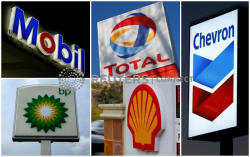Big Oil investors to look past earnings pain and focus
on dividends
 Send a link to a friend
Send a link to a friend
 [April 24, 2020] By
Ron Bousso and Jennifer Hiller [April 24, 2020] By
Ron Bousso and Jennifer Hiller
LONDON/HOUSTON (Reuters) - Investors
already braced for poor first-quarter earnings from major oil and gas
companies next week will focus on how executives plan to save cash and
whether they will cut dividends following the collapse in oil prices.
The five biggest U.S. and European firms, known as the Oil Majors, have
announced spending cuts averaging 23% in a rapid response to the
precipitous fall in oil demand because of the coronavirus pandemic and a
65% slump in crude prices.
With the rout likely to extend for months, the pressure on balance
sheets remains extreme as very few parts of oil company businesses make
money at the current oil price of $20 a barrel.
"This remains a brutal business environment," BP <BP.L> Chief Executive
Officer Bernard Looney said on Thursday.
From Exxon Mobil <XOM.N> to Royal Dutch Shell <RDSa.L>, companies have
put projects on hold, slashed production in U.S. shale fields and
reduced operations at refineries to deal with the double whammy of a
drop in demand and a supply glut.

But more steps are likely to be needed and investors will be watching
closely for changes to output forecasts and to see how companies plan to
manage dividends, the most important incentive for shareholders worth
more than $40 billion combined last year.
"The look back into what was a weak first quarter seems almost
irrelevant. The game plan for dealing with the next three months and the
next 18 months is going to be the focus," said Jefferies analyst Jason
Gammel.
BP will be the first Oil Major to report first-quarter results on
Tuesday, with Shell on Thursday, Exxon and Chevron <CVX.N> on Friday and
France's Total <TOTF.PA> on May 5.
Italy's ENI <ENI.MI> reported a 94% slump in net profit on Friday and
lowered its spending and production forecasts while Norway's Equinor <EQNR.OL>
will report on May 7.
Oilfield services providers Halliburton <HAL.N>, Schlumberger <SLB.N>
and Baker Hughes <BKR.N> have also already taken huge earnings hits in
the first quarter.
DIVIDEND TABOO?
Oil company boards have historically refrained from cutting dividends
during previous crises, resorting to measures such as borrowing money or
offering discounted shares instead of cash.
But Equinor surprised the market on Thursday by becoming the first big
oil company to cut its dividend, slashing its first-quarter payout by
two thirds and suspending a $5 billion share buyback programme.
Most oil companies have tapped debt markets in recent weeks to build
cash reserves, raising at least $50 billion combined.
Exxon, for example, issued $18 billion of bonds in March and April, up
from $7 billion in total last year while Shell has lined up a over $20
billion in new financing in recent weeks.
Some investors, however, have called on them to break the dividend taboo
instead, because debt levels are already high.
[to top of second column] |

A combination of file photos shows the logos of five of the largest
publicly traded oil companies; BP, Chevron, Exxon Mobil, Royal Dutch
Shell, and Total. REUTERS

The sector's dividend yield - the ratio of the dividend to the share price -
soared to its highest in decades following the slide in oil prices and stock
markets in the first-quarter. A high dividend yield can imply investors are
assigning a higher degree of risk to a company's dividend.
Jennifer Rowland, an analyst at Edward Jones, said the dividend outlook was
stable for Exxon, Chevron, Shell and Total though BP may have to look at its
dividend payouts. "Unlike peers, BP's balance sheet is not yet strong enough to
withstand a prolonged period of low commodity prices," she said..
BP declined to comment.
Graphic - Big Oil's dividend yield:
http://product.datastream.com/
dscharting/gateway.aspx?guid=8074aab3-46b3-4b1c-a23d-d64c41000485&action=REFRESH
Graphic - Big Oil's profits:
https://fingfx.thomsonreuters.com/
gfx/ce/bdwvkolevmn/Pasted%20image%201587646408225.png
MAJOR CHALLENGE
First-quarter net income for the sector as a whole is set to fall to its lowest
in at least four years, according to Refinitiv forecasts based on analyst
estimates
But the results are only likely to be a prelude to a disastrous second quarter,
when the full impact on fuel demand from travel restrictions on more than half
of the world's population will be felt.
Benchmark Brent crude oil prices averaged $50 a barrel in the first quarter,
down about 20% from the previous quarter and a year earlier. But Brent futures
<LCOc1> were trading at below $22 a barrel on Friday.
"(Boards) will be asked about plans for operating and capital cost reductions to
survive $30 oil for an extended period," said Doug Terreson, analyst at Evercore
ISI.
Most of the big oil companies require Brent to be at least $40 a barrel to
generate profits so more spending cuts will be needed, he said.
The current downturn challenges the Oil Majors' model, which includes oil and
gas production, refineries and large petrol station networks, in an
unprecedented way.

In previous crises, including the most recent 2014 oil price rout, global
consumption rose sharply in response to low prices, allowing refining and retail
operations, known as downstream, to offset weaker revenue from crude, or
upstream, production.
This time round, both upstream and downstream are in trouble, with global oil
demand expected to drop by up to a third in the second quarter and then recover
only gradually.
Exxon has already said in a filing that its first-quarter results would be hit
by drop in earnings from oil and gas production of about $1.4 billion and about
$800 million from refining compared with the fourth quarter.
(Additional reporting by Felix Bate in Paris; Editing by David Clarke)
[© 2020 Thomson Reuters. All rights
reserved.] Copyright 2020 Reuters. All rights reserved. This material may not be published,
broadcast, rewritten or redistributed.
Thompson Reuters is solely responsible for this content. |